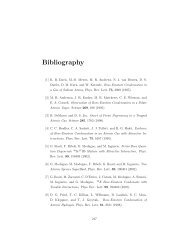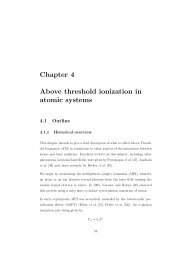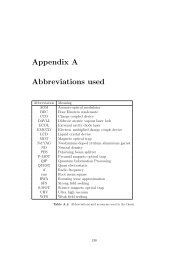A Guide to Acousto-Optic Modulators
A Guide to Acousto-Optic Modulators
A Guide to Acousto-Optic Modulators
You also want an ePaper? Increase the reach of your titles
YUMPU automatically turns print PDFs into web optimized ePapers that Google loves.
A <strong>Guide</strong> <strong>to</strong> Acous<strong>to</strong>-<strong>Optic</strong> Modula<strong>to</strong>rs<br />
1 Introduction<br />
D. J. McCarron<br />
December 7, 2007<br />
Acous<strong>to</strong>-optic modula<strong>to</strong>rs (AOMs) are useful devices which allow the frequency,<br />
intensity and direction of a laser beam <strong>to</strong> be modulated. Within<br />
these devices incoming light Bragg diffracts off acoustic wavefronts which<br />
propagate through a crystal. Modulation of this incoming light can be<br />
achieved by varying the amplitude and frequency of the acoustic waves travelling<br />
through the crystal.<br />
2 How do AOMs work?<br />
Sound waves travelling through a crystal can be modelled as crests of increased<br />
refractive index alternating with troughs of decreased refractive index.<br />
Light incident on gradients in refractive index is scattered, therefore<br />
the light scatters from the acoustic wavefronts. In an AOM the light scattered<br />
from successive wavefronts interferes constructively. Figure 1 shows<br />
two rays of light impinging on two consecutive wavefronts in a crystal. Note<br />
that only some of the light is scattered from these wavefronts. The optical<br />
and acoustic wavelengths are denoted by λL and Λ respectively, while θi<br />
and θd are the angles the incident and scattered light rays make with the<br />
acoustic wavefronts respectively. The condition for constructive interference<br />
of the scattered light is<br />
nλL = Λ(sinθ i + sinθ d ), (1)<br />
where n is an integer [1]. For an optical wave scattering from sound with<br />
a frequency of order 10 8 Hz, it can be shown that the conservation of energy<br />
and momentum requires that θi = θd [2], and so we can approximate<br />
equation 1 as<br />
nλL = 2Λsinθ d . (2)<br />
The Bragg condition would imply that there is only one value of the deflection<br />
angle Θ = 2θd allowed, but this is based on the assumption that<br />
the acoustic and optical wavefronts are plane waves (i.e. infinitely wide),<br />
1
L<br />
v<br />
i d<br />
m = 1<br />
m = 0<br />
Figure 1: The Bragg construction for identifying ray directions with constructive interference<br />
which is only approximately true in practice. If the acoustic beam is of<br />
finite width and the system is optimized for the first order maximum beam<br />
power, i.e. for the Bragg condition with n = 1, the result will be some light<br />
with scattering angle mΘ, where m is the integer corresponding <strong>to</strong> the other<br />
orders[3].<br />
In terms of phonons, scattering in<strong>to</strong> an angle of mΘ corresponds <strong>to</strong> the<br />
absorption or destruction of m phonons whose momenta contribute <strong>to</strong> the<br />
changed momentum of the light, and whose energies are added <strong>to</strong> that of<br />
the scattered pho<strong>to</strong>n. The change in frequency of the input light, ∆f, can<br />
be written as:<br />
m Ephonon<br />
∆f = , (3)<br />
h<br />
where Ephonon is the phonon energy and h is Planck’s constant. Note that<br />
if m < 0, m phonons are created rather than destroyed and the frequency<br />
of the light decreases. In terms of figure 1, this would correspond <strong>to</strong> the<br />
direction of the acoustic waves being reversed.<br />
3 AOM Control<br />
Within an AOM the acoustic wave is provided by a radio frequency (RF)<br />
signal <strong>to</strong> the AOM, controlled by an AOM driver. This driver is made up of<br />
three components, a Voltage Controlled Oscilla<strong>to</strong>r (VCO); a Voltage Variable<br />
Attenua<strong>to</strong>r (VVA); and an amplifier. A schematic diagram of this setup<br />
is shown in figure 2.<br />
The VCO provides a RF sine-wave output, the frequency of the RF output<br />
is determined by an applied control voltage, and varies approximately<br />
linearly with it, see figure 4(a). The VVA attenuates the output from the<br />
2
VCO, the degree of attenuation is controlled by varying the applied control<br />
voltage <strong>to</strong> the VVA. The amplifier amplifies the output of the VVA, such<br />
that the RF output is sufficient <strong>to</strong> drive the AOM. The response of the AOM<br />
varies with the frequency and amplitude of the input RF signal. It is good<br />
practise <strong>to</strong> ensure that the amplifier is separated from the VCO <strong>to</strong> guard<br />
against heating from the amplifier affecting the VCO frequency, whilst ensuring<br />
that the cable connecting the amplifier <strong>to</strong> the AOM is kept as short<br />
as possible <strong>to</strong> minimize any loss of signal or creation of noise.<br />
Control<br />
Voltage<br />
Control<br />
Voltage<br />
VCO VVA AMP AOM<br />
V VCO<br />
V VVA<br />
V AMP<br />
Figure 2: Schematic diagram showing how the VCO, VVA and amplifier are connected<br />
<strong>to</strong> the AOM.<br />
To protect the amplifier when connecting an AOM <strong>to</strong> a RF signal the order<br />
that the three components are connected is crucial. Initially the output load<br />
(AOM) must be connected, the DC supply voltage must then be applied and<br />
finally the RF input (supply and control voltages <strong>to</strong> VCO and VVA) must<br />
be applied. To safely disconnect an AOM from a RF signal this connecting<br />
order is reversed, remove the RF input, remove the DC supply voltage and<br />
then remove the output load (AOM).<br />
4 Setting up a double pass AOM<br />
When a laser’s frequency is scanned with an AOM, the angle of the firs<strong>to</strong>rder<br />
diffracted beam shifts as well, since the beam diffraction angle is a<br />
function of modulation frequency. For many applications this beam shift<br />
is an unwanted side effect and can be effectively eliminated by using the<br />
AOM in the double-pass configuration. Here the output of the m th order of<br />
the AOM is retroreflected for a second pass through the AOM leading <strong>to</strong> a<br />
frequency offset of 2m∆f on the double passed beam. In this arrangement<br />
changing the frequency of the acoustic wave, ∆f, and hence the frequency<br />
of the deflected light, does not cause any steering of the first order output of<br />
the second pass. The output of the second pass counter-propagates with the<br />
3
original input beam. Whilst this is desirable, as it allows the frequency <strong>to</strong><br />
be changed without any steering of the output beam, it poses the problem of<br />
how <strong>to</strong> separate the path of the output beam from that of the input beam.<br />
A λ/4 wave plate is placed just before the mirror and causes the second pass<br />
of the AOM <strong>to</strong> be orthogonally-linearly polarized with respect <strong>to</strong> the first<br />
pass. This allows the beam paths <strong>to</strong> be separated using a polarizing beam<br />
splitter. The setup for a double passed AOM is shown in figure 3.<br />
P4<br />
PBS<br />
Lens 1<br />
AP<br />
P1<br />
AOM<br />
P2<br />
(AOM OFF)<br />
P3<br />
(AOM ON-<br />
1 st ORDER)<br />
Lens 2<br />
AP<br />
/4<br />
Mirror<br />
Figure 3: AOM alignment for double passed light, PBS = polarising beam splitter; AP =<br />
aperture; AOM = acous<strong>to</strong>-optic modula<strong>to</strong>r; λ/4 = quarter wave plate. The labels P1-P4<br />
are beam powers at their specific locations.<br />
Typical properties of the system are defined as:<br />
To align the double pass AOM:<br />
Diffraction Efficiency = P3/P2 (4)<br />
Double Pass Efficiency = P4/P1 (5)<br />
Single Pass Efficiency = P3/P1 (6)<br />
Transmission = P2/P1 (7)<br />
1. Ensure that the laser beam passing through the cube is both horizontal<br />
and aligned over a row of holes in the optical bench. This will make<br />
translating lens 2 easier later.<br />
2. Position lens 1 such that the beam passes through the centre of the<br />
lens. This can be tested by observing the position of the beam downstream<br />
with and without the lens in place. If the lens is correctly in<br />
place there will be no change in the beam position.<br />
3. Locate the focus of the beam. This is done by making knife-edge<br />
measurements of the beam at various positions from the lens. Due <strong>to</strong><br />
the Gaussian profile of the beam it is not sufficient <strong>to</strong> assume that the<br />
4
focus occurs at the focal length of the lens. Now plot the distance the<br />
razor blade had <strong>to</strong> be traversed in order for the beam power <strong>to</strong> drop<br />
from 90% <strong>to</strong> 10% of the maximum as a function of the distance from<br />
the lens. The minimum of this plot corresponds <strong>to</strong> the beam waist.<br />
The beam waist, wx, can be calculated using:<br />
wx = X10−90<br />
, (8)<br />
1.28<br />
where X10−90 is the minimum distance between the points at which<br />
the power output is 10% and 90% of the maximum. This equation can<br />
be used <strong>to</strong> calculate the 1/e 2 radius for any position along the beam<br />
path, provided that the X10−90 distance for that position is known.<br />
Further details on knife-edge measurements can be found in [4].<br />
4. Turn on the AOM and position it at the beam focus, less a small<br />
distance <strong>to</strong> account for the increased optical path length inside the<br />
modula<strong>to</strong>r crystal. This increment is of the order of millimeters and<br />
can be found on the device data sheet. Align the AOM for maximum<br />
diffraction efficiency in<strong>to</strong> the first order. It should be noted that<br />
different AOMs have different active acoustic apertures. This results<br />
in specific beam waists being needed for different AOMs <strong>to</strong> achieve<br />
optimum transmission and diffraction efficiencies [5]. To obtain the<br />
proper optical beam waist diameter, d, stipulated in the device data<br />
sheet the following relationship can be used <strong>to</strong> estimate the required<br />
focal length, F, for lens 1<br />
d =<br />
1.27 F λ<br />
, (9)<br />
D<br />
where λ is the light wavelength and D is the 1/e 2 radius for the input<br />
laser beam. Typically d is of the order of 100 µm and F ranges from<br />
160 <strong>to</strong> 250 mm.<br />
5. Turn off the AOM and insert lens 2 at its focal length from the AOM.<br />
Again test that the beam is central on the lens by observing no change<br />
in the beam position downstream with and without the lens in position.<br />
6. Insert a λ/4 waveplate and a zero degree mirror after lens 2, center<br />
the λ/4 waveplate on the zeroth order beam.<br />
7. Place an aperture at the position of the input beam after lens 1 <strong>to</strong><br />
transmit only the zeroth order light.<br />
8. Retroreflect the zeroth order using the aperture as a guide.<br />
9. Place a power-meter after the cube and fine tune for maximum power<br />
using the mirror and by rotating the λ/4 waveplate.<br />
5
10. Turn on the AOM and move the λ/4 waveplate <strong>to</strong> transmit the first<br />
order diffracted beam. Position an aperture between lens 2 and the<br />
λ/4 waveplate <strong>to</strong> transmit only the first order diffracted light.<br />
11. Final adjustments <strong>to</strong> maximise the double pass efficiency can be made<br />
using the mirror.<br />
12. Optimise the position of lens 2 for minimum beam deflection as the<br />
AOM frequency is changed. This is done by looking at the double<br />
passed light a known distance downstream. Measure the deflection of<br />
the beam for the range of AOM frequencies of interest (typically 110<br />
MHz <strong>to</strong> 80 MHz) using a knife-edge <strong>to</strong> find the beam centre. Now plot<br />
this deflection as a function lens position. The optimum position for<br />
lens 2 corresponds <strong>to</strong> the point where beam deflection is smallest. The<br />
beam deflection is usually given in mrad/MHz.<br />
5 Typical Performance<br />
To test the typical performance of a double pass AOM the setup shown in<br />
figure 3 was made. The polarising beam splitting (PBS) cube used was a<br />
CASIX PBS0201 cube for 780 nm, both lens’ were made by COMAR and<br />
had a focal length of 250 mm (250PQ25-AR). A Crystal Technologies AOM<br />
(3110-120) and a CASIX λ/4 waveplate (WPL1210-780) were used in the<br />
setup. The mirror used was a high reflection coated zero degree mirror for<br />
740-880 nm. The driver of the AOM consisted of a Minicircuits ZOS-150<br />
Voltage Controlled Oscilla<strong>to</strong>r, a Minicircuits ZX73-2500 Voltage Variable<br />
Attenua<strong>to</strong>r, and a Minicircuits ZHL-3A Amplifier.<br />
Initially the RF signal was measured before the amplifier. For an attenua<strong>to</strong>r<br />
control voltage of 15 ± 0.01 V the signal frequency was measured as a<br />
function of VCO control voltage. Then the VCO control voltage was set <strong>to</strong><br />
6.31 ± 0.01 V and the peak <strong>to</strong> peak voltage of the RF signal was measured<br />
as a function of attenua<strong>to</strong>r voltage. The results from these tests can be seen<br />
in figure 4.<br />
The focus of the beam after lens 1 was then found using the method detailed<br />
in part 3 of section 4. The results obtained can be seen in figure 5.<br />
These data clearly show that the focus of the beam occurs at 271 ± 1 mm<br />
away from lens 1. This means that the AOM must be positioned at a distance<br />
of (271-6) mm from lens 1. This increment of 6 mm accounts for the<br />
increased optical path length inside the modula<strong>to</strong>r crystal. This increment<br />
varies for different AOMs and can be found on the AOM data sheet. Using<br />
6
Frequency (MHz)<br />
(a)<br />
160<br />
140<br />
120<br />
100<br />
80<br />
60<br />
0 2 4 6 8 10 12 14 16 18<br />
VCO Voltage (V)<br />
Peak <strong>to</strong> Peak Voltage (V)<br />
(b)<br />
1<br />
0.1<br />
0.01<br />
1E-3<br />
0.4 0.6 0.8 1 2 4 6 8 10 20<br />
ATTN Voltage (V)<br />
Figure 4: (a) Frequency of the RF output as a function of control voltage <strong>to</strong> the VCO.<br />
A linear fit <strong>to</strong> the data gives a gradient of 5.86 ± 0.03 MHz V −1 and a zero voltage offset<br />
of 64.3 ± 0.3 MHz. The reduced χ 2 value for the fit is 2.7, showing that the variation<br />
of frequency with control voltage is not simply a linear relationship. (b) Peak <strong>to</strong> Peak<br />
voltage of the RF output as a function of control voltage <strong>to</strong> the attenua<strong>to</strong>r.<br />
1/e 2 radius (mm)<br />
0.50<br />
0.45<br />
0.40<br />
0.35<br />
0.30<br />
0.25<br />
0.20<br />
0.15<br />
0.10<br />
50 100 150 200 250 300 350<br />
Distance from lens (mm)<br />
Figure 5: Variation of 1/e 2 radius as a function of distance from lens 1. These data<br />
show that the focus of the beam lies at 271(1) mm away from the lens, of focal length 250<br />
mm. This highlights the importance of measuring the position of the beam focus rather<br />
than simply assuming it is at the focal length of the lens. The beam waist was measured<br />
<strong>to</strong> be 0.144(1) mm and the Rayleigh range was 68(1) mm.<br />
the data from figure 5 the M 2 value for the beam can be calculated using<br />
M 2 = πw2 0<br />
. (10)<br />
λ zR,real<br />
The foundations of this equation can be found in [4]. Since real laser beams<br />
deviate from the ideal Gaussian, M 2 > 1 for a real beam and M 2 = 1 for<br />
7
an ideal Gaussian beam. Equation 10 gives M 2 = 1.23(2), this is typical for<br />
a diode laser.<br />
With the AOM correctly positioned in the setup shown in figure 3, it was<br />
aligned for maximum diffraction efficiency in<strong>to</strong> the first order with the AOM<br />
frequency set <strong>to</strong> 110.0(1) MHz. With the AOM switched off the AOM transmission,<br />
defined by equation 7, was measured <strong>to</strong> be 97.6(2)%. The double<br />
pass efficiency, defined by equation 5, was measured with the position of<br />
lens 2 optimized. Results from these measurements can be seen in figure 6.<br />
The diffraction efficiency for the single pass light was then measured as a<br />
Double Pass Efficiency (%)<br />
70<br />
60<br />
50<br />
40<br />
30<br />
20<br />
70 80 90 100 110 120 130<br />
Frequency (MHz)<br />
Figure 6: Variation in double pass efficiency as a function of AOM frequency. The<br />
double pass efficiency is defined by equation 5.<br />
function of the AOM frequency. Using these data the double pass diffraction<br />
efficiency was calculated using the double pass efficiency, equation 5, with<br />
the AOM switched off. The double pass efficiency, with the AOM switched<br />
off, was measured <strong>to</strong> be 90.2(2)%. The AOM alone causes a loss of 4.7% so<br />
the remaining 5.1% of loss is due <strong>to</strong> the 16 optical faces the beam passes<br />
through. Assuming equal loss at each face the transmission is 99.7% which<br />
is in good agreement with typical values for anti-reflection coated optics.<br />
The diffraction efficiency for the double passed light was calculated using<br />
�<br />
P4/P1<br />
Diffraction Efficiency = . (11)<br />
90.2(2)<br />
The data gathered from these measurements and calculations are shown in<br />
figure 7.<br />
Figures 6 and 7 show that the diffraction efficiency, and hence the double<br />
pass efficiency, of a correctly aligned AOM are not constant as the frequency<br />
of the AOM is varied. These data should be remembered when operating<br />
8
Diffraction Efficiency (%)<br />
90<br />
85<br />
80<br />
75<br />
70<br />
65<br />
60<br />
55<br />
50<br />
Single Pass<br />
Double Pass<br />
70 80 90 100 110 120 130<br />
Frequency (MHz)<br />
Figure 7: Variation of the diffraction efficiency as a function of AOM frequency. The<br />
squares show data for single pass light, the circles show data for double pass light. The<br />
error bars on each point are smaller than the shapes used <strong>to</strong> mark the data points for each<br />
plot.<br />
an AOM away from its central frequency.<br />
The method used <strong>to</strong> optimize the position of lens 2, <strong>to</strong> minimize beam<br />
deflection as a function of frequency, is described in part 12 of section 4.<br />
The results gathered using this method, switching the AOM between 110<br />
MHz and 80 MHz, can be seen in figure 8.<br />
Beam Shift (mm)<br />
1.0<br />
0.8<br />
0.6<br />
0.4<br />
0.2<br />
0.0<br />
-0.2<br />
-0.4<br />
-0.6<br />
-0.8<br />
130 135 140 145 150 155 160 165<br />
Lens Position (mm)<br />
Figure 8: Change in beam deflection as a function of the position of lens 2. The AOM<br />
was switched between 110 MHz and 80 MHz. A straight line has been fit <strong>to</strong> the data.<br />
To reduce the error in the intercept the fit has the form y = m(x − c), as this makes the<br />
variables independent. These data show that the optimum position for lens 2 is 149.8(2)<br />
mm away from an arbitrary point on the optical bench.<br />
9
These data show the importance of the position of lens 2, if the lens is positioned<br />
149.8(2) mm away from an arbitrary point on the bench the beam<br />
shift can be minimized of even removed. The beam deflection is typically<br />
given in mrad/MHz, with lens 2 in the optimum position for this setup a<br />
beam deflection of 2 x 10 −4 mrad/MHz was measured.<br />
References<br />
[1] E. I. Gordon. Appl. Opt., 5:1629, 1966.<br />
[2] J. Sapriel, S. Francis, and B. Kelly. Acous<strong>to</strong>-<strong>Optic</strong>s. Wiley, 1979.<br />
[3] A. Yariv. Quantum Electronics. Wiley, 3 rd edition, 1989.<br />
[4] http://massey.dur.ac.uk/resources/grad-skills/knifeedge.pdf. Accessed<br />
on 06/11/07.<br />
[5] Crystal Technology. Acous<strong>to</strong>-<strong>Optic</strong> application note - modula<strong>to</strong>r model<br />
3000 series, Crystal Technology Inc., 1999.<br />
10






